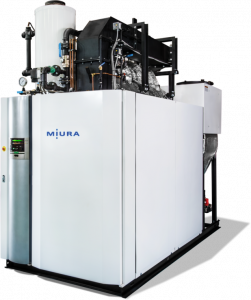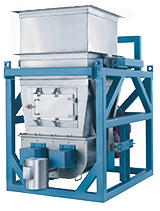What is boiler turndown ratio?
 A boiler turndown ratio refers to the ratio between a boiler’s highest fire setting (maximum output) and lowest fire setting (minimum output). Turndown ratios vary depending on the boiler.
A boiler turndown ratio refers to the ratio between a boiler’s highest fire setting (maximum output) and lowest fire setting (minimum output). Turndown ratios vary depending on the boiler.
For example, if your boiler has a 3:1 turndown ratio, that means that at its lowest fire setting you will be operating at 33% of the boiler’s full capacity. If you have a 10:1 turndown, that means that at its lowest setting, your boiler is operating at 10% of its full capacity.

WHY IS A BOILER TURNDOWN RATIO IMPORTANT?
Generally, a higher turndown ratio provides more flexibility and more efficient operations that translate into significant cost savings over time.
Some facilities need to run their boilers at the highest settings only on infrequent occasions or during seasonal peak demands. Even though these occasions are rare, the facility needs to have enough steam system capacity to meet those demands when they arise. It doesn’t make sense to run a boiler at full capacity 24/7/365, which is why it’s crucial for facilities with fluctuating demands to have a flexible turndown ratio that allows them to “turn down” the capacity to better match their actual demand.
If the boiler does not have a high turndown ratio, facilities don’t have many options for controlling how much fuel they’re using. Operating a boiler system with a high turndown ratio offers these facilities greater efficiency because it can operate at a lower capacity during low-demand times while also meeting those peak demands with ease.
WHAT IS THE TURNDOWN RATIO OF MIURA BOILERS?
Miura Boilers feature turndown ratios of either 3:1 or, in the LX-250 and LX-300, 4:1. You can get an even higher turndown ratio if this boiler is part of a modular system.
While some boilers use a modulating turndown ratio, Miura boilers use a staged turndown ratio. The dual-stage firing sequence means there are two firing modes — low and high. The low-fire setting provides between 25%-60% of the boiler output, and the high-fire provides 100% percent of the boiler output. Boilers with a staged turndown ratio efficiently meet the facility’s steam demand.
A facility with a 600 BHP steam demand might benefit more from a system compiled of (3) LX-200 rather than (2) LX-300. When steam demand drops below the max output or is not needed, the boilers shift into standby mode. In standby mode, steam production halts, but the boiler remains powered on to monitor and sense when there is a need to resume steam production. This drastically reduces fuel consumption compared to leaving the boiler turned on in idle mode.
As you add more boilers to the system, the maximum output increases without affecting the minimum output.
For example, if your modular system contains two Miura LX 300 units, then the system’s turndown ratio increases from 4:1 to 8:1. If the system consists of three units, the ratio increases to 12:1. If the system has four units, the ratio would be 16:1.
Essentially, the more boilers in the modular system, the higher your turndown ratio will be. You can scale your Miura modular boiler system to customize the output and turndown ratio your business needs and scale the system up as required.
LEARN MORE ABOUT MIURA BOILERS
Recommended Posts





